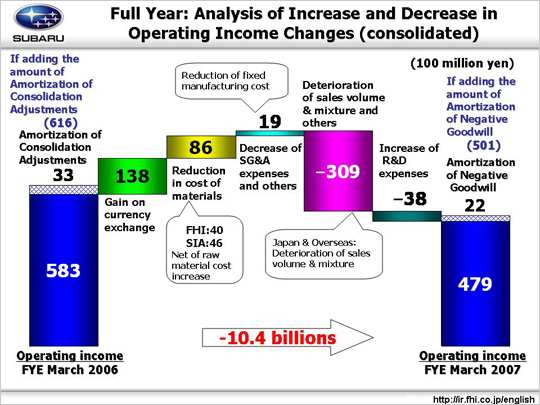Next is an explanation for the causes of increasing and decreasing factors, and which reduced the operating income from 58.3 billion yen to 47.9 billion yen.
Gain on currency exchange added 13.8 billion yen to the income. The weaker yen about 5 yen against the US dollar, added 9.0 billion yen. Also about 9 yen weaker against the Canadian dollar, added 2.1 billion yen through the export from FHI to Canada, and the strong CND$ versus US$ rate added 0.8 billion yen to the export from SIA to the Canadian subsidiaries, for the total 2.9 billion yen increase. The weaker yen about 12 yen against the Euro added 1.9 billion yen.
There were 8.6 billion yen of reduction in cost of materials, 4.0 billion yen of those from FHI, and 4.6 billion yen from SIA. Included in these reductions were 17.0 billion yen by higher raw material prices, due to steel material shortages and other materials such as aluminum and precious metal worsened market conditions.
Decrease of SG&A expenses and others also added 1.9 billion yen to the profits. This is broken down into four parts. First, (1) Reduction in fixed manufacturing cost added 9.1 billion yen to the income, with reduced outsourced die procuring cost (+2.7 billion yen) and lower fixed processing costs (+5.4 billion yen) at FHI, while lower fixed processing costs (+2.4 billion yen) compensated for higher outsourced die procuring cost (-0.8 billion yen) at SIA. (2) Higher SG&A expenses reduced the income (-2.4 billion yen). Lower SG&A expenses in Japan added (+6.1 billion yen) to the income, with (+1.6 billion) at FHI, and (+4.5 billion yen) at the dealerships, etc. On the other hand, SG&A reduced overseas income (-8.5 billion yen), due to SOA (-7.5 billion yen) with incentives per vehicle $350 higher than the last year’s {-5.5 billion yen (-$50M), $1,450 to $1,800}, and higher advertising costs {-1.4 billion yen (-$13M)} and other cost {-0.6 billion yen (-$6M)}. Also, higher SG&A expenses at other overseas subsidiaries reduced the income (-1.0 billion yen). (3) Increased accrued warranty claims reduced the income (-2.0 billion yen). (4) Other items reduced the income as well (-2.8 billion yen).
On the other hand, as a cause of the lower profit, first was a higher R&D (-3.8 billion yen, 46.9 billion yen to 50.7 billion yen). This is due to a higher R&D from the planned introduction of a full model change car in each year from fiscal year 2008 and on for one car model: Impreza, Forester, Legacy, etc.
Also, deterioration of sales volume and mixture reduced the profit (-30.9 billion yen). This is broken down into three parts. (1) The decline in the volume of passenger cars was reflected in lowering the income in Japan (-13.7 billion yen). (2) Overseas (-22.4 billion yen). Both sales volume and mixture were worsened. (3) Inventory adjustments, etc. (+5.2 billion yen) {unrealized inventory +8.9 billion yen (+2.3 billion yen in Japan, +6.6 billion yen overseas), higher profits at the 3 companies and other items (-3.7 billion yen)}.
Based on the above facts, the operating profit resulted in 10.4 billion yen lower yoy basis.
|
